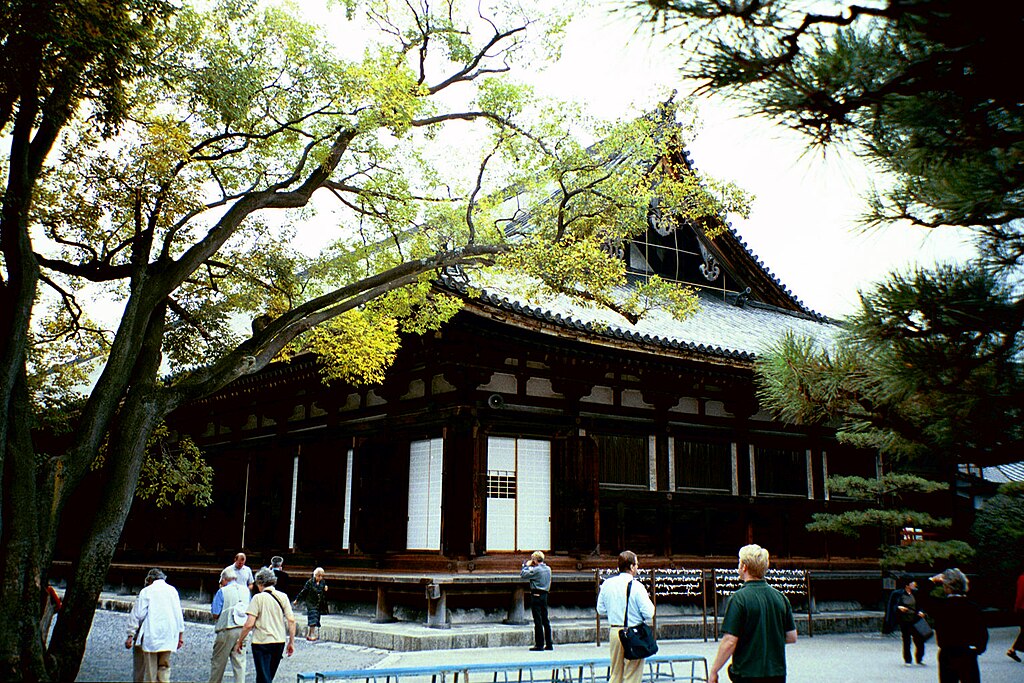What to do in eastern Kyoto
In the east of Kyoto are the Ginkakuji (Silver Pavilion), the Kiyomizudera temple and the Gion district, famous for its Geisha.
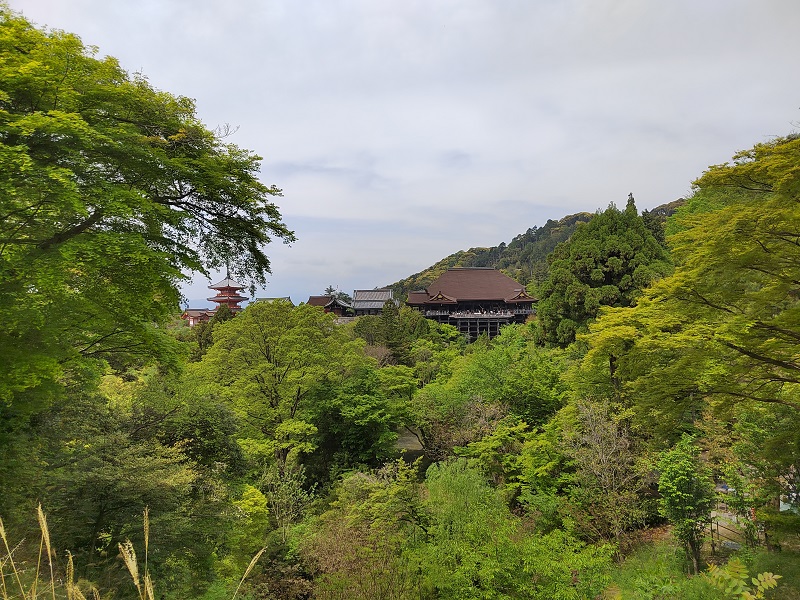
Photo by Japanforeveryone.com
The Kiyomizudera temple in Kyoto is one of the most famous Buddhist shrines in Japan. Situated on a green hill, the temple offers a spectacular view of the city. The temple, originally built in 798, has been rebuilt numerous times over the centuries and has suffered much damage from wars and fires. However, its traditional architecture, with red towers and wooden frames, remains a splendid example of Japanese beauty. The temple is also famous for its water spring that is believed to have healing powers. Kiyomizudera is a must-visit for anyone wishing to immerse themselves in Japanese culture and spirituality.
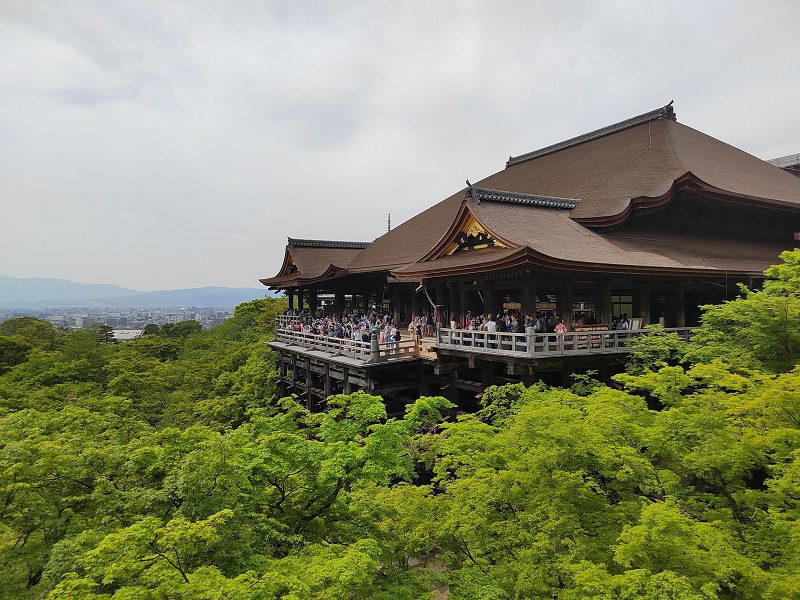
Photo by Japanforeveryone.com
Practical information
| Show location on Google Maps | |
| Official website |
|
| 6:00-18:00 (until 18:30 on weekends and holidays from mid-April until July. Daily in August and September)
For the full calendar of openings please consult the Official website |
|
| No closing days | |
| 500 Yen | |
| Spring and autumn night lighting | |
| 18:00-21:30 (mid-March to mid-April and mid-November to early December). From 17:30 during autumn | |
| 500 Yen | |
| 10 minutes’ walk east of Kiyomizu-michi bus stop (routes 100, 202, 206, 207) |
Higashiyama is one of Kyoto’s most charming districts. Located at the foot of the eastern mountains, this historical district is rich in tradition and authentic atmosphere. It is home to numerous temples, shrines and picturesque streets that enchant visitors. The cobblestone streets, traditional houses and historic shops create a time-travelling feeling. Higashiyama is a great place to explore Kyoto’s culture and history. Highlights include Kiyomizudera, Sanjusangendo and Gion, famous for its traditional geisha. Immersing yourself in Higashiyama is like immersing yourself in Kyoto’s glorious past.
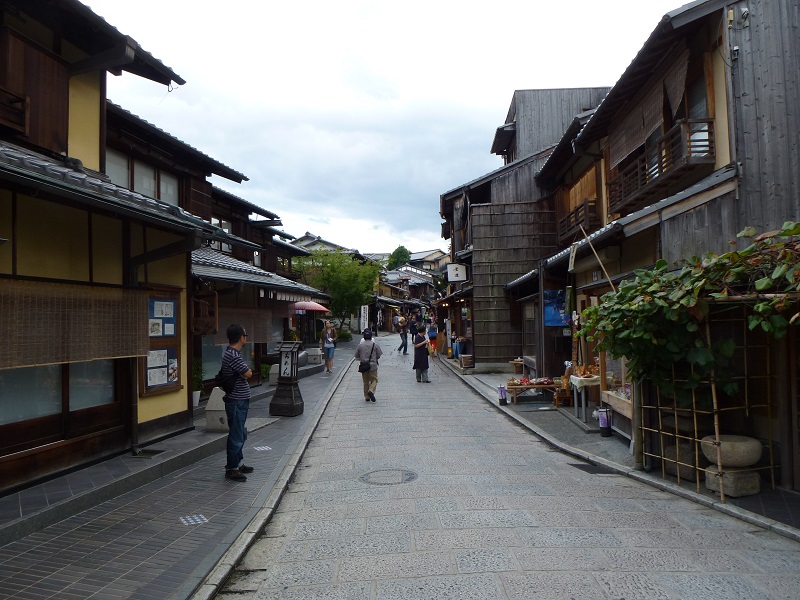
Photo by Japanforeveryone.com
Practical information
| Show location on Google Maps | |
| 10 minutes’ walk east of the Higashiyama-yasui bus stop (routes 100, 202, 206, 207) |
The Ginkakuji Temple in Kyoto, also known as the Temple of the Silver Peacock, is a famous historical site that fascinates visitors from all over the world. Built in 1482, the temple is famous for its elegant and refined architectural style. Its Zen gardens and temple interior are a work of art to be admired for their natural and detailed beauty. The silver peacock, after which the temple is named, refers to the similarity between the effect of the silver sand used to pave the garden and the peacock’s feathers. Ginkakuji is one of Kyoto’s most famous attractions and a must-visit for lovers of Japanese culture.
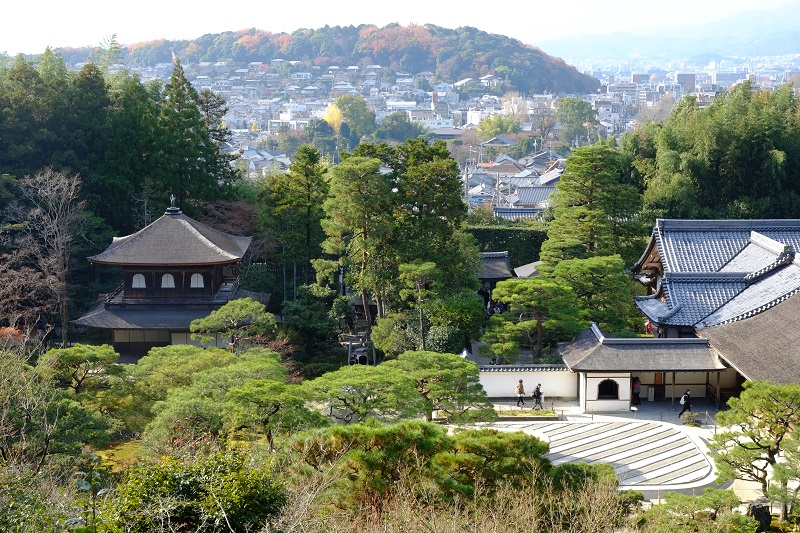
Photo by Japanforeveryone.com
Practical information
| Show location on Google Maps | |
| Official website |
|
| 8:30-17:00 (March to November) 9:00-16:30 (December to February) |
|
| No closing days | |
| 500 Yen | |
| 10 minutes’ walk east of the Ginkakuji-michi bus stop (routes 5, 17, 32, 100, 102, 203, 204) |
The Sanjusangendo Buddhist temple in Kyoto is famous for its impeccable architecture and the history contained within its walls. Built in 1164, the temple houses a large gilded wooden statue of Kannon, the goddess of mercy, along with 1001 smaller wooden Kannon statues positioned to the right and left of the main statue. These wooden Kannon statues, each almost two metres long, were carved with great attention to detail and represent an impressive work of art. The Sanjusangendo temple is a must-visit for lovers of Japanese art and spirituality.
Michael Gunther, CC BY-SA 4.0, via Wikimedia Commons
Practical information
| Show location on Google Maps | |
| Official website |
|
| 8:00-17:00 (from 1 April to 15 November) 9:00-16:00 (16 November to 31 March) Last admission 30 minutes before closing |
|
| No closing days | |
| 600 Yen | |
| 5 minutes’ walk east of the Hakubutsukan-Sanjusangendo-mae bus stop (lines 100, 206, 208) 5 minutes’ walk from Shichijo Station on the Keihan Line |
The Nanzenji Temple in Kyoto is one of Japan’s most important Zen temples. Built in 1291, the temple covers a vast area with enchanting gardens and majestic architectural structures. Its famous main gate, the Sanmon, is one of the largest in Japan and offers a panoramic view of the city. Inside the temple, visitors can admire the sacred frescoes and traditional pitched roofs. The Nanzenji temple is also surrounded by a beautiful park, perfect for relaxing walks. Its beauty and tranquillity make it a must-see destination in Kyoto.
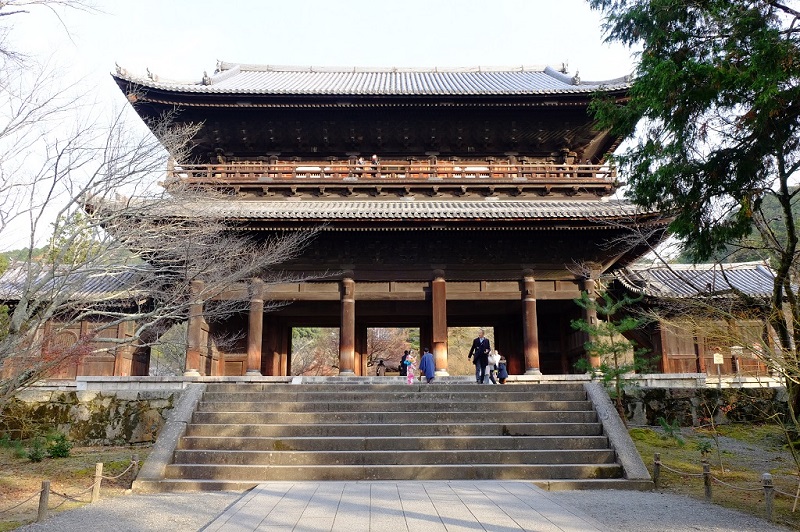
Photo by Japanforeveryone.com
Practical information
| Show location on Google Maps | |
| Official website |
|
| Sanmon Gate | |
| 8:40-17:00 (until 16:30 from December to February) Last admission 20 minutes before closing |
|
| 28 to 31 December | |
| 600 Yen | |
| Hojo Garden | |
| 8:40-17:00 (until 16:30 from December to February) Last admission 20 minutes before closing |
|
| 28 to 31 December | |
| 600 Yen | |
| Nanzenin | |
| 8:40-17:00 (until 16:30 from December to February) Last admission 20 minutes before closing |
|
| 28 to 31 December | |
| 400 Yen | |
| Konchi-in Temple | |
| 8:30-17:00 (March to November) 8:30-16:30 (December to February) |
|
| No closing days | |
| 400 Yen | |
| Tenjuan Temple | |
| 9:00-17:00 9:00-16:30 (in Winter) Special openings on 11 and 12 November (evening lighting) |
|
| No closing days | |
| 500 Yen (600 Yen during evening lighting) | |
| 10 minutes’ walk from the Nanzenji-Eikando-michi bus stop (line 5) 10 minutes’ walk from Keage metro station (T09) |
Gion is a historic district of Kyoto famous for its traditional wooden houses called machiya and performing arts such as geisha and maiko dances. The district still retains the traditional Japanese lifestyle and has an extraordinary charm that attracts visitors from all over the world. During the day, one can stroll along the picturesque streets adjacent to the Kamo River, visit shrines and temples, shop for handicrafts and sample local delicacies. At night, one can see geishas and maikos going to their appointments in the district’s old restaurants and tea houses.
Marcel Montes, CC BY-SA 3.0, via Wikimedia Commons
Practical information
| Show location on Google Maps | |
| Gion bus stop (routes 12, 46, 100, 201, 202, 203, 206, 207) 15-minute walk from Gion-shijo station on the Keihan Line 15-minute walk south from Higashiyama underground station (T10) |
The Philosopher’s Path in Kyoto is one of the city’s most popular tourist destinations. This scenic route along the Kyoto Passage Canal is famous for its natural beauty and the tranquillity it offers visitors. Along the route, one can admire cherry trees, Zen gardens, temples and shrines. The promenade is named after the famous Japanese philosopher Nishida Kitaro, who is said to have taken refuge in this area to meditate. Walking along the Philosopher’s Walk is a relaxing and reflective experience, allowing you to appreciate the beauty and peace of Kyoto.
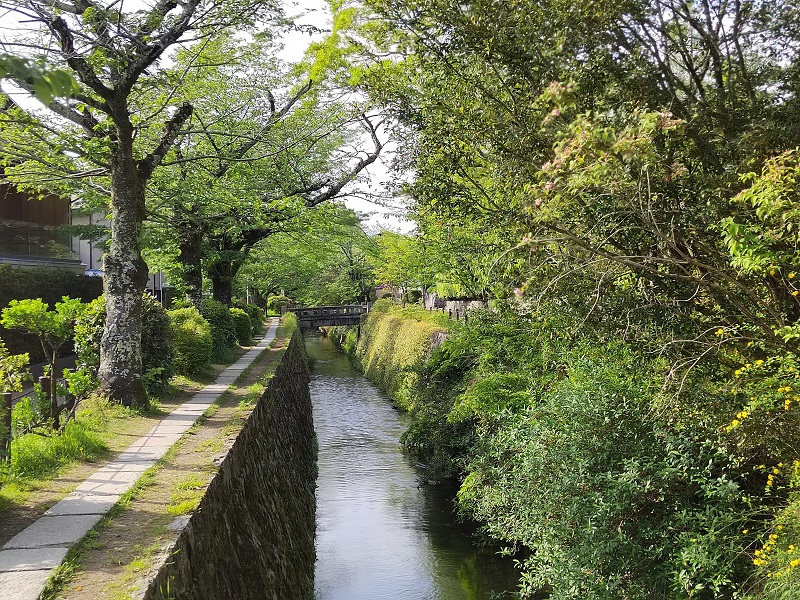
Photo by Japanforeveryone.com
Practical information
| Show location on Google Maps | |
| Official website |
|
| The promenade is located between the Ginkakuji and the Nanzenji |
Kodaiji Temple is a Buddhist temple located in the city of Kyoto. Built in 1606 by the famous samurai and patron Toyotomi Hideyoshi in honour of his late wife, Kodaiji Temple is one of the most important temples in Japan. The temple houses many spectacular structures and gardens, including the bamboo grove and the beautiful Zen garden with a pond. Inside the temple, there are fine and detailed works of art, such as the screens painted by the famous Japanese artist Kanō Eitoku. The Kodaiji temple offers visitors an extraordinary spiritual and cultural experience that reflects the beauty of traditional Japan.
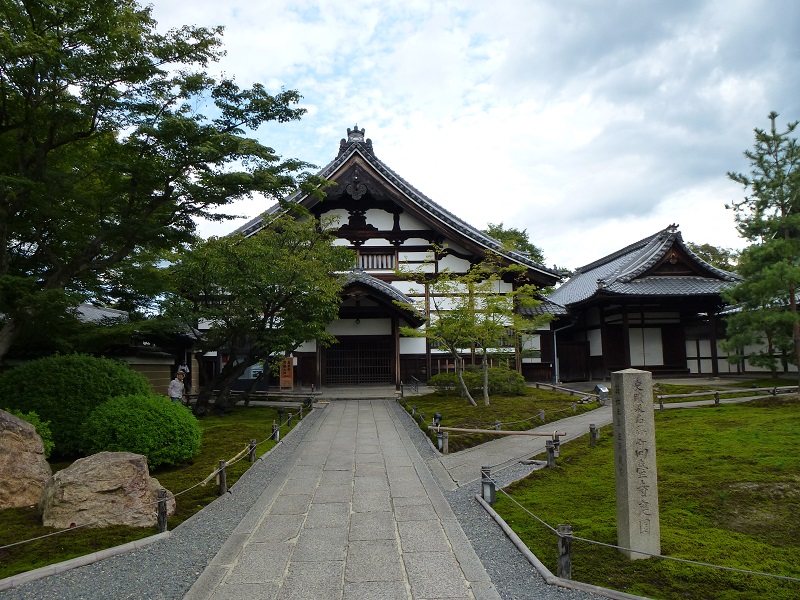
Photo by Japanforeveryone.com
Practical information
| Show location on Google Maps | |
| Official website |
|
| Kodaiji Temple | |
| 9:00-17:30 Last entry 30 minutes before closing time |
|
| No closing days | |
| 600 Yen (Kodaiji and Sho Museum) 900 Yen (Kodaiji, Sho Museum and Entokuin) |
|
| Sho Museum | |
| 9:00-17:30 Last entry 30 minutes before closing time |
|
| No closing days | |
| 300 Yen | |
| Entokuin Temple | |
| 10:00-17:30 Last entry 30 minutes before closing time |
|
| No closing days | |
| 500 Yen | |
| 10 minutes’ walk east of the Higashiyama-yasui bus stop (routes 100, 202, 206, 207) |
The Shorenin temple in Kyoto is a hidden gem that is definitely worth a visit. Built in the 13th century, the temple is nestled in an oasis of tranquillity, surrounded by enchanting forests and gardens. Inside the temple is the iconic main hall with its tatami floors and richly decorated ceilings. Visitors can enjoy the breathtaking view of the Kyoto skyline from the temple’s observation platform. In addition, the Shorenin Temple offers the opportunity to participate in traditional tea ceremonies and guided meditations for a complete spiritual experience.
663highland, CC BY-SA 3.0, via Wikimedia Commons
Practical information
| Show location on Google Maps | |
| Official website |
|
| 9:00-17:00 Last entry 30 minutes before closing time Special openings in the evenings in spring and autumn (18:00-22:00) For more details see Official website |
|
| No closing days | |
| 500 Yen (800 Yen for evening openings) | |
| 5 minutes’ walk south from Higashiyama underground station (T10) and Higashiyama Sanjo bus stop (lines 5, 12, 46, 100, 201, 202, 203, 206). |
The Heian Shrine, also known as Heian Jingu, is one of Kyoto’s main shrines. Built in 1895 to commemorate the 1,100th anniversary of the founding of the city, the shrine is an imposing structure that recalls the architectural style of the ancient imperial court. The highlight of the shrine is its vast garden, characterised by large green spaces, bridges, ponds and a lily pond. During the springtime, thousands of cherry trees in blossom create a spectacular backdrop. The Heian Shrine is a place where spirituality and beauty come together, offering visitors an unforgettable experience.
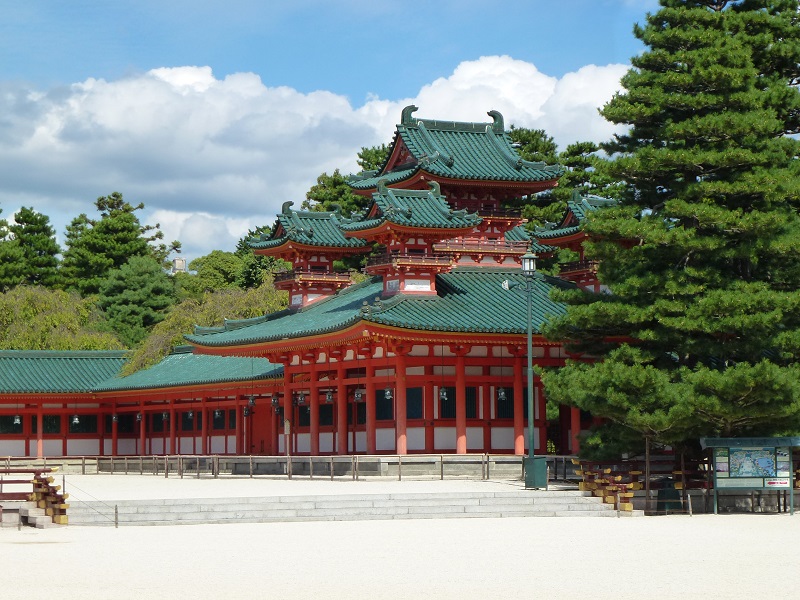
Photo by Japanforeveryone.com
Practical information
| Show location on Google Maps | |
| Official website |
|
| Heian Shrine | |
| 6:00-17:30 (closing time varies seasonally by half an hour) | |
| No closing days | |
| Free | |
| Sanctuary Garden | |
| 8:30-17:00 (closing times vary seasonally by half an hour) | |
| No closing days | |
| 600 Yen | |
| 5 minutes’ walk from Kyotokeikanbijutsukan bus stop (lines 5, 46, 100) 10 minutes’ walk from Higashiyama underground station (T10) The entrance is located to the south |
The Chionin Temple is one of the largest and most important Buddhist temples in Kyoto. Built in the 17th century, the temple is famous for its majestic entrance gate, the largest of its kind in Japan. Inside is the main hall of the temple, which houses a 36-metre high Buddha statue, creating an atmosphere of sacredness and grandeur. The Chionin temple is also renowned for its vast gardens, where visitors can stroll and enjoy the tranquillity and beauty of the landscape. A place of timeless spirituality and beauty, the Chionin Temple is a treasure of Japanese culture.
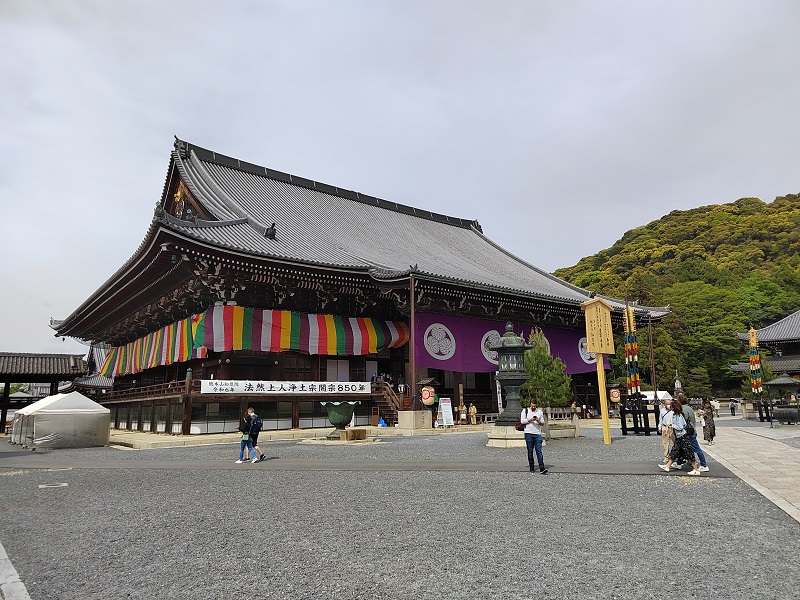
Photo by Japanforeveryone.com
Practical information
| Show location on Google Maps | |
| Official website |
|
| Chionin Temple | |
| 9:00-16:30 Last entry 40 minutes before closing The temple courtyards are always open |
|
| No closing days | |
| Free | |
| Hojo and Yuzen Gardens | |
| 9:00-16:30 (Yuzen) Last entry 30 minutes before closing time 9:00-16:30 (Hojo) Last entry 40 minutes before closing time |
|
| No closing days | |
| 500 Yen (combined ticket) 400 Yen (Hojo garden only) 300 Yen (Yuzen garden only) |
|
| 10 minutes’ walk south of Higashiyama underground station (T10) and Higashiyama Sanjo bus stop (lines 5, 12, 46, 100, 201, 202, 203, 206) |
The Eikando temple, also known as Zenrin-ji, is one of the most beautiful temples in Kyoto. Built in the 9th century, the temple is famous for its spectacular autumn scenery. During koyo, the autumn colour season, the temple is transformed into a living painting, with golden, orange and red leaves enveloping the surrounding gardens and alleys. Beyond the autumnal beauty, the Eikando temple also offers a fascinating temple complex, with art objects and ancient statues. A must-see for lovers of nature and Japanese culture.
Martin Falbisoner, CC BY-SA 4.0, via Wikimedia Commons
Practical information
| Show location on Google Maps | |
| Official website |
|
| 9:00-17:00 Special openings in the evenings in autumn (7 November to 6 December daytime hours from 9:00 to 17:00, evenings from 17:30 to 21:00) Last admission one hour before closing (30 minutes before during evening openings) |
|
| No closing days | |
| 600 Yen (1000 Yen in autumn during the day and 600 Yen in the evening) | |
| 10 minutes’ walk from the Nanzenji-Eikando-michi bus stop (line 5) 10 minutes’ walk from Keage metro station (T09) |
Yasaka Shrine, also known as Yasaka Jinja, is one of Kyoto’s most important and ancient places of worship. Built more than 1,350 years ago, the shrine is famous for its summer festival, the Gion Matsuri, which attracts thousands of visitors every year. The shrine is an important cultural landmark in the city and hosts many traditional activities such as ritual dances, prayers and tea ceremonies. Surrounded by a magnificent green area, the Yasaka shrine is a place of great charm and spirituality, representing a unique and authentic experience of Japan.
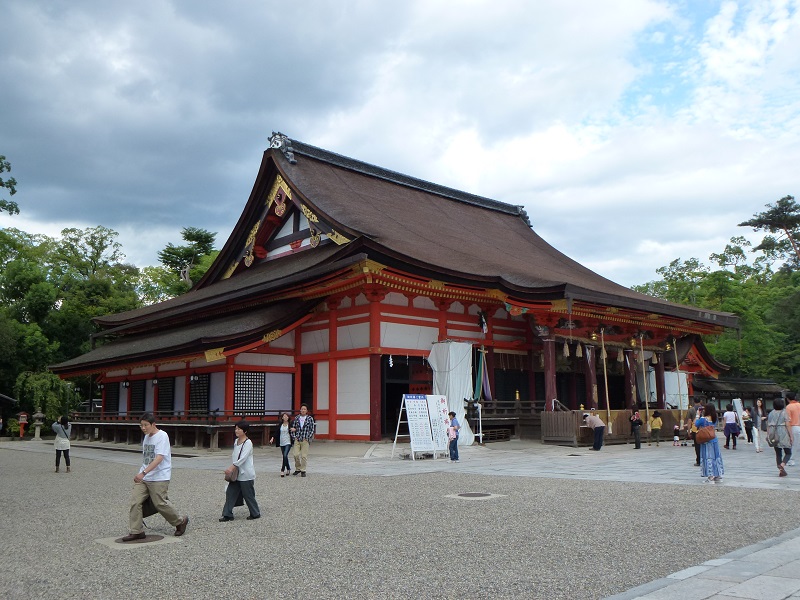
Photo by Japanforeveryone.com
Practical information
| Show location on Google Maps | |
| Official website |
|
| Always open | |
| No closing days | |
| Free | |
| Gion bus stop (routes 12, 46, 100, 201, 202, 203, 206, 207) 15-minute walk from Gion-shijo station on the Keihan Line 15-minute walk south from Higashiyama underground station (T10) |
Maruyama Park is a beautiful public park located in the heart of Kyoto. Known to be one of the best places to admire the cherry blossoms during the sakura season, Maruyama Park attracts visitors from all over the world. Besides cherry trees, the park offers a wide variety of trees and plants, as well as a picturesque lily pond. The park is also famous for its large stone lantern, the largest of its kind in Japan. An oasis of nature and tranquillity, Maruyama Park offers a refuge from the hustle and bustle of the city and an enchanting experience for all travellers.
Yanajin33, CC BY-SA 4.0, via Wikimedia Commons
Practical information
| Show location on Google Maps | |
| Always open | |
| No closing days | |
| Free | |
| Gion bus stop (routes 12, 46, 100, 201, 202, 203, 206, 207) 15-minute walk from Gion-shijo station on the Keihan Line 15-minute walk south from Higashiyama underground station (T10) |

